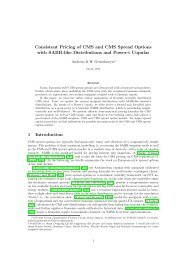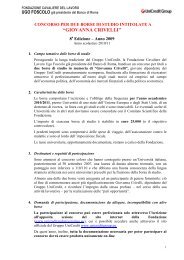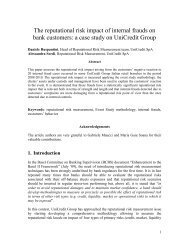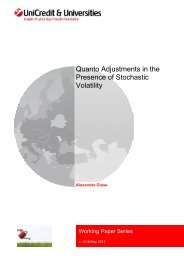Dóra Fazekas Carbon Market Implications for new EU - UniCredit ...
Dóra Fazekas Carbon Market Implications for new EU - UniCredit ...
Dóra Fazekas Carbon Market Implications for new EU - UniCredit ...
Create successful ePaper yourself
Turn your PDF publications into a flip-book with our unique Google optimized e-Paper software.
field of environmental protection, which is financed by the installation when allowances are too<br />
expensive. The literature suggests, however, that the more volatile allowance prices are, the later<br />
the installation makes supplementary investments that are the higher the prices of allowances shall<br />
be. (Nagy-György, 2005)<br />
Assessment practice in Hungary roughly corresponds to that of the rest of Europe. In Hungary, the<br />
most frequent pricing type is that based on preventive marginal cost. As opposed to other rights of<br />
financial value, the value of the allowance is not determined by benefits and expected future<br />
revenue arising from the possession of the allowance. In reality, it is only the relative market supply<br />
and demand and their situation and volume that influence market prices of allowances. As a result,<br />
the price of allowances has fallen under 1 <strong>EU</strong>R by the end of the first period, down from the<br />
original unit price between 10 <strong>EU</strong>R and 15 <strong>EU</strong>R: Member States allocated too many allowances<br />
and thus there is a surplus, with only few companies in scarcity wanting to purchase them.<br />
Provision<br />
A central feature of the allocation and trading of emissions allowances is that the operators shall<br />
surrender allowances <strong>for</strong> the quantity emitted in the current year by April 30 of the following year.<br />
Thus the operator is obliged to make provisions under the Law on Accounting: “provisions shall be<br />
<strong>for</strong>med to the debit of pre-tax profit or loss – to the extent necessary – to cover payment liabilities<br />
toward third persons which originate from past and current transactions and contracts and which are<br />
likely or sure to be incurred by the balance sheet date, however the amounts of such liabilities are<br />
not established by the balance sheet preparation date and the company has not provided the required<br />
cover <strong>for</strong> such in any other <strong>for</strong>m”. (Law on Accounting, Section 41, Paragraph 1). According to<br />
Law XV of 2005, Section 5, Paragraph 1, “the operator shall follow up the emission of greenhouse<br />
gases falling under the emissions allowance according to special legislation and submit an audited<br />
report <strong>for</strong> the environmental protection authority relating thereto by March 31 of the following<br />
year.” The fact that actual figures might be evident only after the balance sheet date is not contrary<br />
to the applicability of the provision, since “during the <strong>for</strong>mation of a provision, liabilities that exist<br />
on the balance sheet date and the estimated expenses shall or may be taken into account even if they<br />
become known between the balance sheet date and the date of closing” (Law on Accounting,<br />
Section 41, Paragraph 9).<br />
As a result, the operator should determine the quantity of allowances to be surrendered with regard<br />
to the balance sheet date, which corresponds to the emissions in the current year, and then it should<br />
deduct the quantity, which is covered by the delayed revenue indicated on the liabilities. (This is the<br />
remaining quantity of allowances allocated <strong>for</strong> free by the state at the end of the year.) The<br />
112









